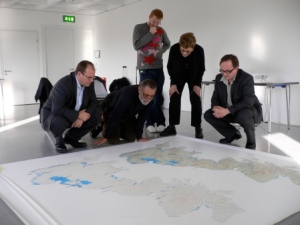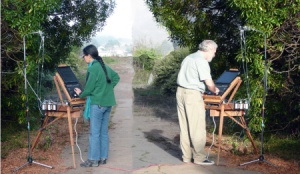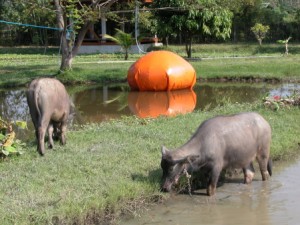This post comes to you from EcoArtScotland
This piece was first published in New Energies, the Land Art Generator publication for the 2014 Copenhagen competition. Land Art Generator will be keynote speakers at the ‘Feeding the Insatiable‘ Art and Energy Conference at Schumacher College in November.
Why is ‘working together’ so vital right now? It is at the heart of ecoart practices and at the heart of the Land Art Generator Initiative. It is one of the features that distinguishes these practices and programs. LAGI asks architects, designers, and artists (a.k.a. “creative practitionersâ€) to work with scientists, engineers, inventors, land managers, ecologists, manufacturers, and communities.
There are several elements to working together. Teamwork is considered to be an important skill. In fact, it is part of the national curriculum in Scotland (2009). Participation has become mainstream in art, design, architecture, and new media. Interdisciplinarity is the mot du jour in academic research. Collaboration and creativity, participation and knowledge have become powerful words in the discourse today, but they are double-edged. Do they reinforce existing marketization, or do they open up new forms of public space?
LAGI invites teams to form and work together, ideally with communities, to develop new solutions for our societies’ energy systems and to imagine new structures for generating renewable energy at the mid-scale—the scale that relates to settlements. LAGI wants us to embrace renewable energy as a beautiful part of the places we live.
“Embracing†is a good word in this context, because we need to embrace renewable energy. It is also a good word for the particular sense of working together, because creative and techno-scientific practitioners need to embrace each other’s skills and expertise, knowledge and methods. LAGI is not looking to decorate existing energy installations or plop down energy-producing sculptures. This embrace must not be uncritical. The future of energy must be renewable, and it must be socially just. The BBC reported when the renewable energy system on Eigg, an island off the west coast of Scotland, came online. What wasn’t reported was the social justice built into the system. Renewable energy is limitless over time, but limited at any point in time. On Eigg, every house and business has a cut-out switch, which stops an individual from using too much energy at any particular moment. This is a form of community collaboration, which is significant and which addresses the “tragedy of the commons†(the tendency for people to act in their own short term interests even if this has long term negative consequences for the community). On Eigg people embrace each other with social as well as environmental justice.

If we want to understand why working together with artists might be important, it is worth looking to the practice of Helen Mayer Harrison and Newton Harrison. These eminent ecological artists responded to an invitation from David Haley (Director, Ecology in Practice, Manchester Metropolitan University, UK) to consider the impact of global warming on the island of Britain. The result was the project Greenhouse Britain: Losing Ground, Gaining Wisdom (2006–2008) funded by the UK government as part of its Climate Challenge program. In the independent evaluation of that project, Wallace Heim comments on interviews she conducted with the Harrison’s project collaborators:
They all reported that the experience was illuminating, informative, challenging, imaginative, liberating. Their respect for the cross-disciplinary knowledge of the Harrisons was high, including both the science, the land-use planning and the architectural aspects, including Newton Harrison’s ability to ask ‘the right questions.’ Further, they had been taken on a journey, relieved of the strictures of their respective disciplines and work practices, and had found it in some way transformative of their way of considering climate change and possible adaptations to it. But, from their responses, the exercise was not just one of being relieved of limitations, but one which was highly informed, creative, and reflective, not just of their own methods of work, but of more conventional responses to climate change. They reported feeling supported, mentored, and reported an appreciation of what this kind of process of ‘art’ can achieve in providing the context, the time and space for imagining possible futures, for rehearsing what may happen. (2008, p.9)
The words that Heim chooses to characterize the experience of collaborating with the Harrisons are also used by others when speaking about the quality of collaborative relationships between artists and scientists. LAGI is seeking to provide a context, time, and space for that quality of informed, creative, and reflective practice to imagine possible futures and rehearse what can happen as we embrace renewable energy.
There are dangers, however, in focusing on an idealized form of collaborative practice, a fetishized meeting of minds. What Heim’s description does not suggest is that the result of Greenhouse Britain is a problem solved. Rather it is making sense of our new circumstances and exploring what some futures might look like.
In his essay The Negotiation of Hope (2005), Jeremy Till addresses John Forester’s argument that the role of designers in particular should be understood as “sense-making†rather than “problem-solving.†Till states:
“Central to Forester’s argument is that such a move from the problem to sense-making necessarily brings with it an acknowledgement of the contested social situation in which the design process is first initiated….â€
When we step outside our specialized spaces, whether the galleries, concert halls, and theaters of artists, or the labs of scientists and engineers, we are negotiating our practices. Increasingly, we are negotiating with communities as well as other professions. Creative practitioners working with ecological systems, human habitation and development, energy and resource generation, and so on, quite specifically embrace other ways of working, in particular other methods. They can enter into deep relationships. There is a sharp edge here, because this involves dealing with other living things, not just inert materials. Therefore, this embrace has to be respectful, has to have an ethical dimension, has to be caring.

To understand what this might mean, Tim Collins and Reiko Goto’s project Plein Air (2010–2014) required that they work with engineers to develop a range of sensing technology. This technology enabled the public to perceive trees breathing and, in collaboration with musicians and audio artists, to transform the data streams of that breathing into acoustic experiences. Collin’s and Goto’s concern was to encourage empathy, using technology to heighten awareness.
In being collaborative, we are often being interdisciplinary—working between, with, across, into, and beyond disciplines and between different forms of knowledge and practice. Sometimes conversations explore the similarities between artists and scientists, designers and engineers, but a discipline is a specialization. With specialization comes skill and expertise. Ecoart always requires multiple and varied skills and expertise. There are many dimensions to this. Creative practitioners tend to have thematic interests, such as water, biodiversity, urban greenspace, brownfields, phyto-remediation, farming, orchards, and permaculture. Ecoartists will name their collaborators and will report, and sometimes document, the dialogues.
I’m increasingly concerned about the terms “collaboration†and “interdisciplinarity†because these words might be obscuring the basic act of “working together.†However, not all “working together†is the same. David Haley (2011), using the analysis of Basarab Nicolescu, suggests some ways of thinking about the differences. A group of people with different specializations can all work on the same question. This might be called “multi-disciplinary.†If those people exchange methods, so that the specializations become hybrid, then that might be called “inter-disciplinary.†Then there are circumstances where different specializations come together to focus on a problem, setting aside any hierarchies of specializations, and this might be called “trans-disciplinary†(the prefixes post- and extra- have also been used). Haley argues that the repositioning of specializations, clarified by this terminology, is vital to address 21st Century questions. I would argue that ecoart is inherently interdisciplinary—it is not just the knowledge domains that are embraced. If you look at a lot of ecoart, it actually sits in grey areas between art and design—not clever product design, but design in the sense of clear communication of information, clear construction of process resulting in impacts. Joachim Sauter opens up the issue when he states:
In short: the result of design work has to be understood immediately and should be directly legible by as many as possible. This means it has to be told in a language that everyone understands. Artwork however is produced using an individual and personal language and it is mainly not meant to be understood immediately or by everyone. The process of understanding an artwork by deciphering is very important. It forces one into a much deeper dialogue with what is presented. In design work it is the opposite—if there is a fire, you don’t want to decipher an exit sign. It goes without saying that the borders are blurry and that you find both approaches in both fields. (2010, p.250-251)

Perhaps the Danish collective Superflex might exemplify this issue. In addition to their work 2000 Watt Society Contract, which relates to the collaboration on Eigg mentioned above, Superflex’ Supergas project sits in this blurry, in-between space. The Supergas website Introduction page states:
In 1996–1997 Superflex has collaborated with biogas engineer Jan Mallan to construct a simple, portable biogas unit that can produce sufficient gas for the cooking and lighting needs of an African family. The system has been adapted to meet the efficiency and style demands of a modern African consumer. It is intended to match the needs and economic resources that we believe exist in small-scale economies. The orange biogas plant produces biogas from organic materials, such as human and animal stools.
First note that the engineer is credited in the first sentence. Second, the Supergas project appears to conform to Sauter’s description of design. In Tanzania, Cambodia, Thailand, Zanzibar, and Guadalajara, the project’s function is clear. When seen in an art exhibition, however, for example at the Louisiana Museum, Denmark (1997) or at Marres, Centre for Contemporary Culture, in Maastricht (2011), it becomes a kind of personal language that requires deciphering. In those contexts, it becomes an “issue-based†work of art. There is a third position from which it also needs to be deciphered. As Mallans states in an interview:
“That’s also different from industry. In industry you don’t ask whether there is any money. Of course, there is. But here you know there’s no money.†(1999)
Creative practitioners working on environmental and ecological projects, including those contributing to LAGI, might be attempting to operate, like Superflex, in both of Sauter’s modes. Their works often operate at more than one level—to understand immediately what the project is doing and make it directly legible, but also to enter into a deeper dialogue through a more personal relationship with the work.
In exploring collaborations between artists and communities, Grant Kester is interested in the politics of collaboration:
In the most successful collaborative projects we encounter instead a pragmatic openness to site and situation, a willingness to engage with specific cultures and communities in a creative and improvisational manner …, a concern with non-hierarchical and participatory processes, and a critical and self-reflexive relationship to practice itself. Another important component is the desire to cultivate and enhance forms of solidarity…. (2011, p125)
Kester’s defining characteristics are leitmotifs. In particular ‘solidarity’ is a political word (perhaps more so if you are connected to Poland and grew up in the 80s), but it signals the importance of respect and justice in the process, echoing openness to site and situation, reinforcing engaging with specific cultures and communities, and embedding an alternative politics.
Kester’s phrase “a critical and self-reflexive relationship to practice itself†opens up space for the practice to inhabit the blurry space between clarity and directness on the one hand, and depth and personal language on the other.
The reason we might need to rethink our understanding of creative practice, as suggested at the start of this essay, is because the most provocative examples of ecoart, and LAGI in particular, are characterised by a shared process rather than an autonomous one. The artists are not adding decoration to something that engineers have designed, and the designers are not simply designing the logo for the product. There’s a deep understanding that to make sense of our energy challenges and to intervene effectively takes multiple intelligences, multiple practices, multiple creativities working together.
References
HALEY, David (2011). Art, Ecology and Reality: the Potential for Transdisciplinarity in the Proceedings of Art, Emotion and Value. 5th Mediterranean Congress of Aesthetics http://www.um.es/vmca/proceedings/docs/52.David-Haley.pdf accessed 12 March 2014
HEIM, Wallace (2008). Evaluation Report DEFRA Climate Challenge Fund CCF9 Project code AE017 Greenhouse Britain: Losing Ground, Gaining Wisdom. http://greenhousebritain.greenmuseum.org/evaluation/ accessed 12 March 2014.
KESTER, Grant (2011) The One and the Many: Contemporary Collaborative Art in a Global Context. Durham and London: Duke University Press.
SAUTER, Joachim (2010) interview in Data Flow: v. 2: Visualizing Information in Graphic Design. Berlin: Gestalten
SCOTTISH GOVERNMENT (2009) Curriculum for Excellence: Building the Curriculum for Skills for Learning, Skills for Life and Skills for Work.
SUPERFLEX (1999) Superflex: Tools. Verlag der Buchhandlung Walther Konig
SUPERGAS website http://www.supergas.dk/introduction/ accessed 12 March 2014
TILL, Jeremy (2005). The Negotiation of Hope, in Architecture and Participation London and New York: Taylor Francis
![]()
ecoartscotland is a resource focused on art and ecology for artists, curators, critics, commissioners as well as scientists and policy makers. It includes ecoartscotland papers, a mix of discussions of works by artists and critical theoretical texts, and serves as a curatorial platform.
It has been established by Chris Fremantle, producer and research associate with On The Edge Research, Gray’s School of Art, The Robert Gordon University. Fremantle is a member of a number of international networks of artists, curators and others focused on art and ecology.
Powered by WPeMatico

